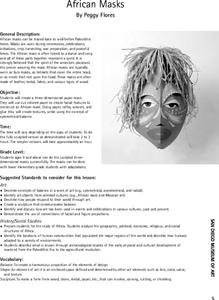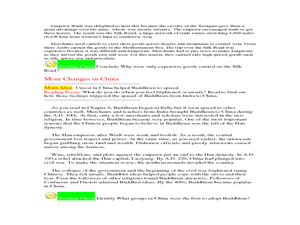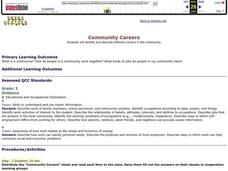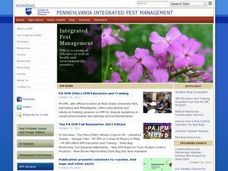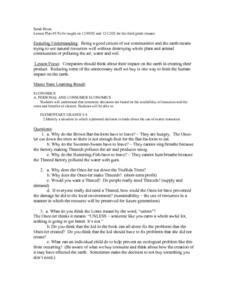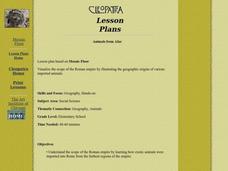Curated OER
African Masks
Fourth graders create three-dimensional paper African masks. They analyze the geographic, political, economic, religious, and social structures of Africa. they discover that masks were worn for various ceremonies.
Curated OER
Patterns of Settlement in Early Alabama
Fourth graders study the settlement of Alabama. They collect data from the U.S. census website and answer questions regarding settlement patterns in the counties of Alabama in 1820. They write a paagraph describing where they would have...
Curated OER
Solving Your Problems
Students listen to story about solving personal problems. They study about handling problems and practice what they have studied in real life situations. They then complete the worksheet for comprehension.
Curated OER
Siege and Battle of Corinth
Students complete a variety of activities that go along with the study of and possible fieldtrip to thesite of the Siege and Battle of Corinth in Mississippi. They examine the role transportation routes played in the formation of their...
Curated OER
Korean Road Trip
Pupils research the geographical regions of Korea. They plan a hypothetical road trip that could be taken in the country. Students also write a study journal for the trip that records possible events that could take place.
Curated OER
The Constitution
Students determine that the rules that we follow in America were written in the Constitution. They study a copy of the constitution and discuss how it compares and differentiates from the plan the class has written. They recite our...
Curated OER
First Grade, First Grade, What Do You See? (Elementary, Reading/Writing)
First graders assist in making a list of the many things that Brown Bear saw in the story. They create an illustration of the person, place, or thing that they wrote about in their pattern sentence.
Alabama Learning Exchange
President's Day for Special Education/Early Elementary
Students investigate how both Abraham Lincoln and George Washington displayed the trait of honesty. They listen to read alouds of class books and poems that address both the lives of these men and the trait of honesty. They use a graphic...
Curated OER
Themes to Encourage Awareness of Environmental Changes on the Shoreline of Connecticut in Elementary School Students: The Case of Kelsey Island
Students begin the lesson by developing a map of Kelsey Island by following specific instructions. In groups, they are given a block of ice in which they tie a rope around and drag over various rocks for different distances. They...
Curated OER
The Golden Rule of Reciprocity
Young scholars explore The Golden Rule of Reciprocity from various religions. For this religious beliefs lesson, students examine various religious quotes and summarize the idea of The Golden Rule in a sentence.
Curated OER
Aztec Floating Gardens
Aztecs created amazing hydroponic gardens called Chinampas, to grow their crops. Learners in grades k-7 engage in four mini-experiments to understand just how amazing floating gardens are. Tip: A perfect way to bring science into your...
Curated OER
Wars and Conflicts
Students explore the concepts of war and conflict. For this research skills lesson, students use Internet and print sources to research the causes, effects, main events, and significant figures of selected wars.
Curated OER
Early China
Learners journey back in time to early China. In this Chinese history lesson plan, students explore China's geography; read about the Shang, Zhou, and Han Dynasties; compare Confucianism and Daoism. Learners create PowerPoint...
Curated OER
Trust
Students define trust. For this social skills lesson, students read The Other Side and interact with their classmates to define what trust is.
Curated OER
Feminization of Work
Students explain trends in the work of women and men. They examine why work has increasingly become feminized internationally and engage in a class discussion about their own situations at home regarding work.
Curated OER
Community Careers
Second graders examine what a community is. They identify various occupations in their community, complete a handout, and discuss how people in their community work together.
Curated OER
Weeds-Wild and Wonderful
Students compare and contrast weeds and desirable plants. They explore the ways which their ancestors used weeds and depended on them for food and other household necessities.
Curated OER
Economics -- Third Grade
Third graders read the Dr. Seuss book The Lorax. In groups, they answer questions that are related to economics and distribution of goods. They also identify the environmental issues present in the book and perform a skit in front of the...
Curated OER
Laws - Who needs them?
Students examine the need for laws. In this government instructional activity, students participate in 2 classroom activities that require them to consider the impact of laws on their personal lives. Students discuss how laws solve...
Curated OER
Predicting the Past
Pupils study how archaeologists record the past. They discuss archaeology and artifacts. They view a list of artifacts discovered by Marquette at the Illinois Village and answer questions regarding them. They complete a test about three...
Curated OER
History Today
Students use the newspaper to determine how history is being made in your community, region or country.They identify the different components that comprise a newspaper. This lesson contains adaptations from elementary to high school.
Curated OER
Living in America (The Earliest Years)
Fifth graders work in groups to study a particular group of Native Americans. They use a study guide to guide their research and use the internet and text resources to gather information. Students post their research on a class web page.
Curated OER
Was the Stamp Act Fair?
Students examine British and Colonial perspectives on the Stamp Act.
They determine whether or not the act was fair. Students are intrdouced to the social and economic forces that pushed Americans toward Revolution.
Curated OER
Animals from Afar
Pupils visualize the scope of the Roman empire by illustrating the geographic origins of various imported animals. They study how exotic animals were imported into Rome from the farthest regions of the empire.
